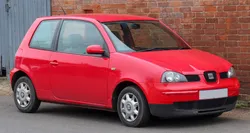

Seat Arosa Generation 1 Facelift 2000 Overview
Explore the Seat Arosa Generation 1 Facelift 2000, its features, and performance details. This compact car is a notable choice in Portugal for city driving.
The SEAT Arosa Generation 1, which received a facelift in 2000, is a compact city car that was produced by the Spanish automaker SEAT. This first-generation model, introduced in 1997, und...
Technical Specifications
Select Version
Dimensions
Engine
Driving
Others
History and Features
Mycarro AI
Feb 1, 2024
Introduction
The SEAT Arosa Generation 1, which received a facelift in 2000, is a compact city car that was produced by the Spanish automaker SEAT. This first-generation model, introduced in 1997, underwent a refreshing update three years later to improve its aesthetics and add some new features. The facelift aimed to modernize the Arosa, making it more appealing to its target audience and keeping up with the evolving automotive trends.
Design and Exterior
The facelifted SEAT Arosa Generation 1 received significant changes to its exterior design. The front end was restyled, showcasing a more prominent grille and reshaped headlights that gave the car a sleeker and more modern appearance. The bumper was redesigned as well, featuring new air intakes that added a sporty touch to the vehicle. At the rear, the taillights were revised, incorporating a more refined and contemporary design language.
Interior and Features
Inside the SEAT Arosa Generation 1, the facelift brought several updates to enhance comfort and convenience. The seats were redesigned, providing better support and increased comfort for both the driver and passengers. The dashboard received subtle modifications, including new materials and improved ergonomics. Additionally, new features such as power windows, central locking, and a CD player were introduced, making the Arosa a more appealing choice in the compact car segment.
Engine and Performance
Under the hood, the facelifted SEAT Arosa Generation 1 retained its range of efficient and reliable engine options. These included gasoline engines with various power outputs to suit different driving preferences. The Arosa also offered diesel engine options, providing excellent fuel efficiency and low emissions. Despite its compact size, this city car delivered a nimble and agile driving experience, making it suitable for urban environments.
Safety and Technology
The facelifted SEAT Arosa Generation 1 introduced several safety and technological advancements. It featured improved braking systems, including anti-lock brakes (ABS) and electronic brake-force distribution (EBD), enhancing the car's overall safety performance. In terms of technology, the Arosa offered optional features such as air conditioning, power steering, and an onboard computer, providing drivers with added convenience and comfort.
Reception and Legacy
The facelifted SEAT Arosa Generation 1 received positive reviews for its refreshed design and upgraded features. Its compact size and maneuverability made it an ideal choice for urban dwellers. With its fuel-efficient engines and affordable price tag, the Arosa appealed to cost-conscious buyers. Although the model's production ended in 2004, it left a lasting legacy in the SEAT lineup, influencing future city car designs and setting the stage for future generations.
Conclusion
The facelifted SEAT Arosa Generation 1, introduced in 2000, brought a fresh and updated look to this compact city car. With its redesigned exterior, improved interior, and new features, the Arosa remained a popular choice in its segment. Its efficient engines, safety enhancements, and technological advancements made it a practical and enjoyable car to drive. Although the first generation of the Arosa is no longer in production, its legacy lives on, showcasing SEAT's commitment to producing stylish and functional vehicles for urban environments.
